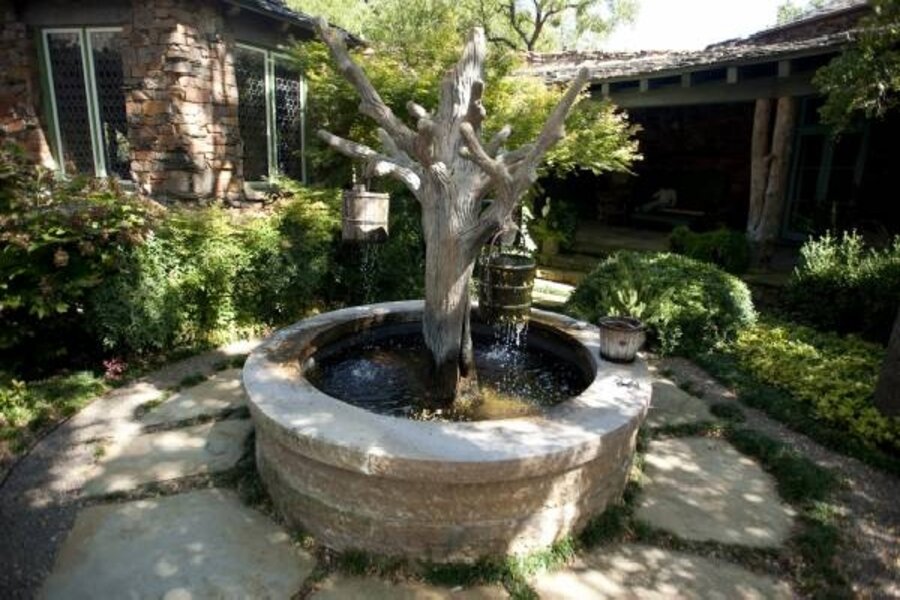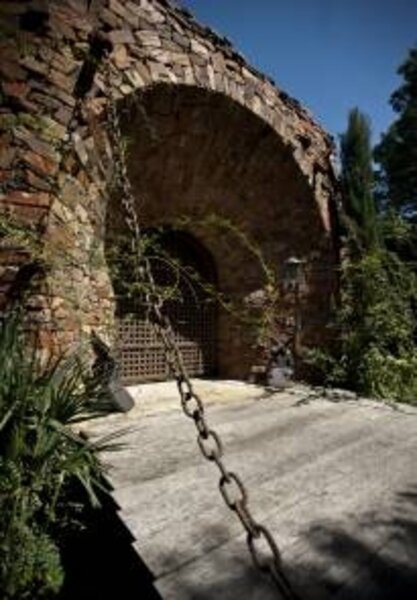A fairy tale garden for a hobbit
Loading...
| Dallas
"Beyond this place there be dragons," reads the sign over a courtyard door, visible once you've walked across a drawbridge, over a moat, and passed through ornate iron gates. Let it be known there are talking trees and fairy woods, too.
So begins an enchanted excursion through a unique property in Preston Hollow, Texas. It is wholly unlike its neighbors on this narrow, winding, blacktop road of old estates and new, grand mansions.
The house and grounds were not built for show but for the delight of their imaginative owner and her five grandchildren.
Guided by their client's fantasies, the professionals who designed, installed, and maintain the gardens and grounds have had to create separate compartments, intellectually. The property does not conform to standard operating procedure, for this is a land inhabited by hobbits.
Rule one:
Hobbits are short, about 4 feet tall. The maintenance crew with Southern Botanical, the Dallas firm that installed and maintains the landscape design, must leave overhanging limbs and thick, coiled vines intact. The canopy on pathways through the native woods can be cleared no higher than 4 to 5 feet, to retain the sense of mystery and discovery around every turn.
Rule two:
The property requires meticulous attention to detail, but it must look naturally wild.
Rule three:
All seasonal flowers in the small
garden outside the dining room's wall of windows — including hydrangeas in summer and bridal wreath in spring — must be white, twinkling, and sparkling like a fairyland.
Rule four:
The property must be maintained using organic methods and products.
"The imagination started with her," landscape architect Rosa Finsley says of the homeowner. The 1-acre lot, bisected by a creek, was overgrown with vines, trees and bushes, some of them invasive species.
Privet and wax-leaf ligustrum, planted by birds, are left alone, Ms. Finsley says, because the homeowner wants to preserve her thicket of privacy and because the large shrubs' berries are a food source for wildlife.
"We protected as much of the woodsy vegetation as we could," Finsley says. "The idea was to fit the garden into it."
The homeowner doesn't shrink from mixing fantasies. The wall flanking the drawbridge was inspired by the gardens of Ninfa, an abandoned medieval town southeast of Rome.
Constructed of sandstone and slate, the deliberately higgledy-piggledy wall is studded with glass bottles — bottoms out — and partly obscured by a tangle of white Lady Banksia roses that spill over the top and down the sides. Blackberries replicate the brambles clinging to Sleeping Beauty's castle.
The courtyard just inside the gates feels like Santa Fe or San Antonio, set with highly collectible faux-bois concrete furniture and planters. A faux-bois tree trunk, spilling water into rusty buckets, is the focus of a round stone fountain. The craftsman who made the custom feature used existing cedar elms in the courtyard as the pattern for its faux bark.
The house, finished in 2006, initially was to be a replica of White O'Morn, the whitewashed stone cottage that John Wayne's character in "The Quiet Man" reclaims in the Irish village of his birth.
"We told them to put up the cheapest stone because we were going to whitewash it," says the owner. The stonemasons' work turned out "too stately, too fancy, too nice" to be masked by paint and, besides, the city of Dallas would not allow a thatch roof.
The architecture's premise, therefore, became a "Tolkien-inspired cottage." Hipped roofs facing this way and that are shingled with a deliberate jumble of old slate, new slate, tiles and other materials.
Fixtures, furnishings and finishes live up to the high-fantasy descriptions in J.R.R. Tolkien's fiction. There are replicated eagle's nests used as light fixtures in the high-ceilinged living room, a grottolike powder bath with intricate shell mosaics covering the walls and a secret passageway in the study.
Just outside the house, close enough for tea parties, there is a custom Edwardian conservatory furnished with another faux-bois concrete table and chairs. Finsley furnished the climate-controlled glass house with ferns and other humidity-loving plants.
Some of the fanciful elements came about as solutions to difficult drainage. The property is at the low point on the street's undulating terrain. Rainstorms, groundwater, and neighbors' poorly designed irrigation systems send water streaming from all sides to collect here.
At first, the design team thought to bury a network of drains to direct the water to the creek below the house.
"There's water draining down here 24-7," says Jason Craven, president of Southern Botanical. "Even during the worst drought in 50 years. We said, why not capture it?"
Consequently, a deeply set brook that recirculates and seeps over mossy rocks was constructed like a moat along the front facade of the house.
Overflow is directed through a series of channels to the back of the house to fill a deep cistern 10 feet above and 10 feet below the ground. If it fills to capacity, which it did this summer with all the rain, an overflow spout near the top splashes 10 feet to a waterway leading to the lazy creek.
A natural-looking pool is fitted with aerators to keep the water moving to thwart mosquitoes' hatching. The water also has been stocked with minnowlike mosquito fish, also called gambusia, which eat mosquito larvae.
The cistern, which also serves as an overlook into the woods (or a fort or a prison tower, depending on who's playing what imaginary game), has a 12-inch-thick rock veneer. Southern Botanical's crew dug the below-ground space by hand and jackhammer, then hauled out the rock and dirt in wheelbarrows.
"It's in solid, solid, solid, solid rock," says Jason New, Southern Botanical's manager of the ongoing project. "We couldn't get machinery in here without tearing everything up."
"That's why there are still woods around here," Finsley says. "We lost no trees to construction damage."
"And she has never used a drop of city water to irrigate," Mr. New adds.
Landscaped gardens are situated next to the house, in partially sunny beds. Finsley specified white-flowering trees and shrubs that she has come to rely on over a career dealing with North Texas soil and climate.
Years ago, Finsley founded Kings Creek Nursery in Cedar Hill, Texas, where she lives. It became a destination for gardeners in the know (and is now called Petal Pushers Garden Emporium by its third owner). She collected several plants on her international travels and propagated them for her landscape design jobs and for sale to the public.
The hobbit garden holds several: a toad lily with a light orchid flower; a hardy, mounding campanula from Italy with light purple flowers that looks good trailing over walls and rocks; and a Korean pittosporum that is more cold-hardy than what is usually available in this region.
In front of a screen of 'Claudia Wannamaker' magnolias, Finsley planted white Encore azaleas that bloom off and on all year. Compact white 'Gumpo' azaleas and holly ferns hide the bare "ankles" of the larger Encores.
"'Claudia Wannamaker' is my very, very favorite magnolia," says Finsley. "They grow a maximum 16 feet wide. They're such a great thing on the edge of an estate; they stop the view. But there are not that many nurseries growing them now.
"We preserved the wildness and created a garden within it," Finsley says, explaining her plan. "We tried to keep it as a home for wildlife. If we do our gardens right, we can preserve the homes of the creatures who were here before us and share it with them."
Whether hobbits count as wildlife, this homeowner has created a specialized habitat for them, too. Out of sight of the main residence, along a woodsy path and across a low-water crossing of steppingstones, is a mushroom-shape house. Everything inside is miniaturized, from the beamed ceilings and small chairs pulled up to the fireplace to the low doorways that cause adults to duck.
It will serve as a guesthouse and playhouse for her grandchildren, when they are old enough. Adults are allowed to sleep over only in the company of children. There's a winding stair for the grown-ups to descend, but the young and young at heart take the built-in fiberglass slide.
"The architects helped develop a plan, and we implemented it," Mr. Craven says. "But the client had the vision. From movies, books and her own imagination she came up with the ideas. She often talked about how she wanted it to be a magical, whimsical place with fairies, a place that she thought hobbits would like."
Editor’s note: For more on gardening, see the Monitor’s main gardening page, which offers articles on many gardening topics. Also, check out our blog archive and our RSS feed. You may want to visit Gardening With the Monitor on Flickr. Take part in the discussions and get answers to your gardening questions. If you join the group (it’s free), you can upload your garden photos and enter our contests.






